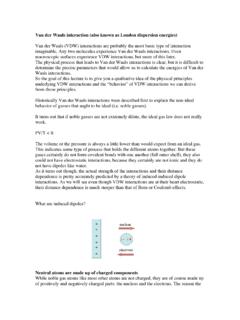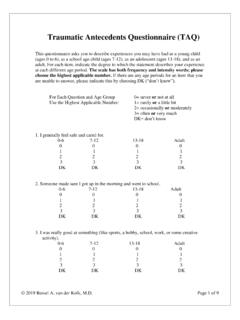Transcription of Digital Trade Restrictiveness Index
1 Digital TradeRestrictivenessIndexby Martina Francesca Ferracane Lee-Makiyama Erik van der Marel Trade Restrictiveness IndexEuropean Center for International Political Economy (ECIPE)40 Avenue des Arts1040 BrusselsThe authors are extremely grateful to Fredrik Erixon for guidance and comments throughout the project process. A special thanks goes to Hanna Deringer who provided an excellent research contribution to this report. We also would like to thank in addition Gabriel Agostini, Niccol Bonifai, Maria del Carmen Vasquez, Giorgio Garbasso, Rositsa Georgieva, Sara Holmberg, and Antonella Zarra for their research Trade Restrictiveness IndexContentsExecutive Summary1. Introduction2. DTRI Rankings 3. DTRI Results Cluster A: Fiscal Restrictions Cluster B: Establishment Restrictions Cluster C: Restrictions on Data Cluster D: Trading Restrictions 4. DTRI Methodology DTRI Clusters DTRI Chapters References Annexes: A: DTRI Cluster and Chapter Tables B: How To Use the DTE Website C: Weighting D: European Union and Member States E: Country Codes and Names46132324365162737476119120130133135 1364 Digital Trade Restrictiveness IndexExecutive Summary The Digital Trade Restrictiveness Index (DTRI) measures how 64 countries in the world restrict Digital Trade .
2 This new and ground-breaking Index reveals that many leading economies put significant restrictions on Digital Trade . These restrictions drive up costs for businesses as well as for consumers. Free Digital Trade , on the other hand, provides consumers with better access to services and goods, and helps businesses in all sectors of the economy to become more efficient and reach new RESTRICTIVE TO Digital Trade This Index shows that China is the most restricted country in Digital Trade . China applies sweeping regulatory measures in all aspects of Digital Trade , including Trade in Digital goods and services, investment in the information and communications technology (ICT) sector, as well as the movement of data and ICT professionals. China is followed by Russia, India, Indonesia and Vietnam. They all have very restrictive regimes for Digital Trade . Generally, the countries that are most restrictive in Digital Trade are emerging economies.
3 China belongs to that group, but it is also an outlier because the country imposes substantially higher restrictions on Digital Trade than other emerging economies. Just like China, Russia also applies more burdensome Digital Trade restrictions than could be expected given its level of economic development. COUNTRIES OPEN TO Digital Trade The country that is most open in Digital Trade , with only a few Digital Trade restrictions, is New Zealand. Iceland, Norway, Ireland and Hong Kong are also among the most digitally open countries. These countries are the five least restricted economies in Digital Trade and have free Trade policies applied in most fields of the Digital economy. All Top Five countries in Digital openness are comparatively small economies and therefore more dependent on global markets. Generally, they also have a larger services sector than other countries, which reinforces the role of open Digital markets for their economic growth.
4 All five countries have a tradition of being open to international Trade and investments. Their Digital openness boosts productivity and investments in so-called knowledge-based intangibles such as research and developemnt (R&D), design, ( Digital ) training and data, which spurs growth in Digital and non- Digital sectors. And the reality for all countries is that the combination of open Digital borders and a friendly domestic regulatory climate for businesses expands economic prosperity. EUROPE AND THE UNITED STATES In Europe, the two most digitally restricted countries are France and Germany. Both countries have more restrictive Digital Trade policies than most other developed countries. France is also the only European country that is part of the Top Ten most restricted countries in Digital Trade worldwide. Romania is the third most restricted European country, with a score significantly lower than France and Germany.
5 Besides Ireland and Norway, other European countries that rank high in Digital openness are Malta, the Netherlands, Latvia, Luxembourg and Estonia. This group of countries illustrates that, also in Europe, the most digitally open countries are small economies with a larger services sector compared to digitally restricted countries in Europe. 5 Digital Trade Restrictiveness Index Even if the United States is home to many successful Digital companies, it applies various restrictive policies in Digital Trade that are holding back certain sectors of its Digital economy. The Index shows that the US has a level of Digital Restrictiveness that is just above the average level of Restrictiveness in all countries TAKEAWAY POINTS FROM THE Index Digital Trade brings clear economic benefits for both businesses and consumers. Digital Trade is already one of the main driving forces behind sustained economic growth, because it helps countries to improve productivity, a key indicator for technological advancement and the chief source of future economic welfare.
6 The Index shows that policy responses to digitalisation have been very diverse. Some countries which are relatively small, open and services-oriented embrace the global Digital transformation with a long-term perspective, whereas countries that are relatively bigger and emerging often respond with skepticism and significant restrictions to Digital Trade . The high level of Digital Trade restrictions in emerging economies is worrying because these restrictions undermine their capacity to develop their economies on the back of new technologies in an increasingly data-based global economy. The Digital transformation underway affects all sectors and businesses, and a restrictive regulatory environment for Digital Trade will weigh down many non- Digital sectors. The Restrictiveness of these countries may also be a harbinger for how global policy developments in Digital Trade will unfold.
7 The Top 10 countries most restricted in Digital Trade cover nearly half of the world population. The policy choices that these countries make will certainly have an impact on how global Digital policies will take THE Digital Trade Restrictiveness Index (DTRI) The DTRI is based on a wide spectrum of Digital Trade policies covering more than 100 categories of policy measures across 64 countries worldwide. The Index is the first global initiative to provide transparency of applied Digital Trade restrictions and sheds light on how countries compare with each other. The Index is based on the Digital Trade Estimates (DTE), a database that ECIPE has developed and that is freely available for anyone to use. The database and the Index are clustered around four larger areas of Digital Trade policy, namely (A) Fiscal Restrictions and Market Access, (B) Establishment Restrictions, (C) Restrictions on Data, and finally (D) Trading Restrictions.
8 Each cluster contains more specific policy areas, referred to as chapters. Cluster (A) covers Tariffs and Trade Defense, Taxation and Subsidies and Public Procurement. Cluster (B) covers Foreign Investment Restrictions, Intellectual Property Rights measures, Competition Policy and Business Mobility. Cluster (C) covers Data Policies, Intermediate Liability and Content Access. Finally, Cluster (D) includes Quantitative Trade Restrictions, Standards and Online Sales and Trade Restrictiveness Index1. IntroductionDigital Trade is an important part of the world economy and the movement of data across borders is now a central feature of globalisation. It is therefore critical for the health of the world economy, and for the prospect of economic growth in all countries, that markets are open to the movement of Digital goods, services and investment, ICT professionals, and data. Openness to Digital Trade will also shape the wider Digital economy.
9 It helps businesses to reach foreign Digital markets and to provide access to better Digital suppliers around the world. It benefits consumers by providing better value for money and a greater variety of Digital goods and services to choose from. Digitalisation, therefore, is today one of the main driving forces for higher levels of productivity a key source for long-term economic growth. Digital protectionism, on the other hand, slows down productivity in the Digital economy. It therefore reduces the prospects for increasing living standards. Digital protectionism will eventually prevent countries from reaping the full economic rewards from all the investments they have made, and continue to make, in the Digital economy. However, not all governments embrace the consequences of digitalisation. In fact, the changes that digitalisation provoke have led some governments to resist the calls for a greater space in the economy for new Digital business models.
10 For instance, when sectors such as transport and tourism, historically considered as non-tradable sectors, have become tradable, several governments have acted to protect them against Digital disruption. In fact, some countries have reacted to digitalisation by imposing sweeping economic restrictions on Digital competition, ultimately affecting Digital Trade . For all these reasons, ECIPE is now launching the Digital Trade Restrictiveness Index (DTRI). The DTRI maps and measures policy restrictions to Digital Trade all of which are driving up the cost of doing business across borders in 64 countries. The Index covers many Trade policy restrictions in the Digital economy varying from tariffs on Digital products, restrictions on Digital services and investments, restrictions on the movement of data, and restrictions on e-commerce. It is the first Index of its kind, and it aims to increase transparency in how governments restrict Digital Trade .






